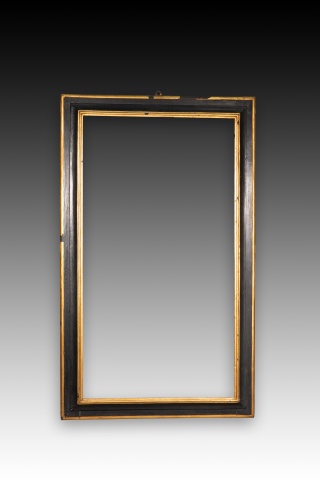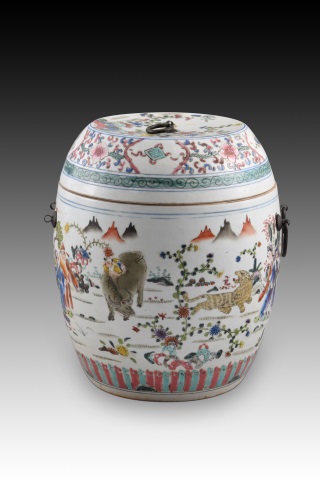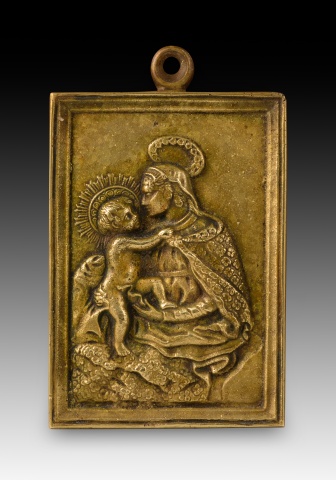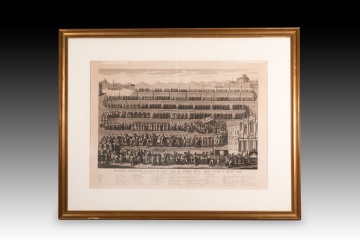
-
Axe. Wrought iron. 20th century. Tall wrought iron torch holder with a tripod base formed by scrolls and a triangular piece from which the axis emerges (with a balustrade profile with discs). This ends in a plate from which an openwork piece starts that would hold the candle. The scrolls, the lines of the axis, simplified plant details, etc. show a clear influence of ancient works, especially from the Baroque of the 17th century. This inspiration is frequent within the framework of Historicisms.
· Size: 38x38x133 cms
ANTIQUES
MISCELLANEUS;OTHER OBJECTS
Ref.: ZF0310
-
Jug and glass. Glass. Royal Glass Factory of La Granja de San Ildefonso, Segovia, Spain, 18th century. Jug or vase with lid and glass with a small spout made of clear, carved and engraved glass, decorated with plant elements and architectural motifs of classical influence. They were made in the Royal Glass Factory of La Granja de San Ildefonso, founded in 1727 by Buenaventura Sit and, initially, as a furnace for flat glass to supply the nearby Royal Palace. Shortly after, they would diversify their production, becoming one of the main centres in Spain.
· Size: Jarra 10x10x33 cms. Vaso 13x13x15 cms
ANTIQUES
MISCELLANEUS;OTHER OBJECTS
Ref.: ZF0878
-
Sold

Frame. Carved, polychrome, and gilded wood. 18th century. It has faults. Rectangular frame made of carved wood with a black area flanked by two gilded areas on the outside and inside of the piece, with a flat area in both colors and a different one, again in both finishes. Stylistically, it recalls examples common in numerous European schools since the Renaissance.
· Size: 85x6x140 cms. Int 68x123,5 cms
ANTIQUES
MISCELLANEUS;FRAMES
Ref.: ZF1338
-
Espagnolette. Wrought iron. 18th century. An iron element made up of several pieces firmly joined together, with simple decoration based on rings and other details, used to close a door or window. This type of piece was very common in the construction of important residences. Available 1 unit
· Size: 30x13x250 cms.
ANTIQUES
MISCELLANEUS;OTHER OBJECTS
Ref.: Z3485E
-
Pair of andirons. Blued and gilded bronze, iron. 19th century. Fireplace andirons decorated with vine leaves and bunches of grapes on the side pieces and in the centre of the horizontal part, working the metal to also remind us of the plant. These three elements or areas are visually united by an openwork piece, decorated in a simpler way with motifs inspired by Neoclassicism.
· Size: 36x45x45 cms.
ANTIQUES
MISCELLANEUS;OTHER OBJECTS
Ref.: ZF0126
-
Candlestick. Bronze. 17th-18th centuries. Candlestick made of bronze with a circular base and an axis combining discs, balustrade shapes, smooth areas, concave and convex mouldings of different widths, etc., creating a very lively profile common in this type of pieces since the Baroque in various European schools and reminiscent in some details of the so-called spool candlesticks. Weight: 520 gr.
· Size: 21x21x55 cms.
ANTIQUES
MISCELLANEUS;OTHER OBJECTS
Ref.: ZF0491
-
Frame. Carved and gilded wood. 18th century. Rectangular frame with a semicircular top in the centre, crowned by a composition with leaves and elements of the Passion of Christ (Crown of Thorns, Nails, etc.) decorated with a series of bands, alternating plain ones with two different strings of pearls. Although the 18th century is known for Rococo, it is not the only artistic style of the period: the decoration and shapes of the frame show a closer relationship with ancient Roman art, a common influence in Neoclassicism.
· Size: 44x8x81 cms
ANTIQUES
MISCELLANEUS;FRAMES
Ref.: ZF0527
-
Sword. Metal, leather. Royal Factory of Toledo, towards the end of the 19th-20th century Small sword with a garnish bearing the emblem of the Infantry and the simplified coat of arms of Spain on the other side, cap with the monogram of King Alfonso XIII and wire-wrapped hilt, featuring a Toledo blade (inscription “Fca de Toledo”) and a scabbard combining leather and metal, slightly curved. Compare with the small sword for Infantry Officers, model 1901.
· Size: 12x2x97 cms.
ANTIQUES
MISCELLANEUS;OTHER OBJECTS
Ref.: ZF0575
-
Oval case. Silver. 19th century. With contrast marks. Oval box with flat lid made of silver, partially gilded, decorated on the outside with framed figurative scenes and landscapes and geometric motifs arranged in bands and architectural and plant motifs. The Rococo influence can be seen, for example, in the frames chosen for the landscapes on the body of the piece and in the figurative scene on the lid. Weight: 96 grams. Hallmarks are on the inside.
· Size: 6x4,3x2,2 cms.
ANTIQUES
MISCELLANEUS;SILVER
Ref.: ZF0690
-
Pair of stirrups. Carved wood, iron. Chile, 18th century. Pair of stirrups made up of a block of carved wood, in the shape of a half moon at the front, and decorated on the outside with geometric and vegetal elements, and an iron surround. Since metal was reserved for other uses during the 18th century, wood began to be used more frequently to make stirrups in Chile. The shape of the present pair, which follows a common typology of the time, seems to have been derived from Asturian pieces, preferred over metal stirrups to protect from water, branches, etc., and the artisanal development carried out mainly by the Jesuits in the area was what led to this type of carving and decoration, which survives to this day.
· Size: 16x20x17 cms.
ANTIQUES
MISCELLANEUS;OTHER OBJECTS
Ref.: ZF0933
-
Sold

Oriental barrel-shaped vessel. Porcelain, metal. China, 20th century. With marks on the base (apocryphal, Xangxi). A barrel-shaped vessel with a flat lid, made of white-ground porcelain and decorated with a polychrome figurative composition based on plant motifs and scrolls on the lid, and upper-class figures set in a garden with pavilions, a large censer, a tiger and other animals, etc., on the body, on a frieze of repeated elements and under a double blue line at the top (this last detail also separates the stripes on the lid). Morphologically, it is reminiscent of the Chinese porcelain seats often used in gardens, but note that it has a lid with a metal washer and handles of the same material, elements that are not found on the known seating pieces. Next to these courtiers in the pavilion is a male figure on a water buffalo (a frequent motif in Chinese art, associated with either wise men or peasants or shepherds). The marks on the base, located within a double circular line, resemble those used on Chinese porcelain made during the Kangxi Empire (1662-1722), but are considered apocryphal.
· Size: 25x25x30 cms.
ANTIQUES
MISCELLANEUS;CERAMIC
Ref.: ZF1082
-
Spice rack in glazed ceramic. Talavera de la Reina, 18th century. A three-cup spice rack in the shape of an equilateral triangle, made of ceramic and decorated with high-temperature enamels typical of Talavera polychromy: manganese black for the edges and antimony oranges and yellows, copper green and cobalt blue. It is a classic-style piece, with clean lines that delimit the different parts of the structure, well-organised decoration and synthetic motifs that refer to the Greco-Latin ornamental repertoire, such as the palmette and the acanthus leaf.
· Size: 16x14x4,5 cms.
ANTIQUES
MISCELLANEUS;CERAMIC
Ref.: ZF1255
-
Advertising poster, Magin Rubio Factory. Paper or cardboard. Spain, possibly around 1900. The Magin Rubio Chocolate and Mantecados Factory was located in a modernist mansion built by Eduardo Sánchez Eznarriaga at the beginning of the 20th century to house both production and the home of the company's founder, Magín Rubio González. It currently houses the Astorga Chocolate Museum.
· Size: 22,5x0,1x34,5 cms
ANTIQUES
MISCELLANEUS;GRAPHIC WORK
Ref.: ZF135437
-
Hunters, pair of panels. Porcelain. Possibly Germany, 19th century. Pair of wall plaques with metal pieces to hang on the top and a polychrome figurative decoration on the front, in relief. One shows a horseman dressed in furs, accompanied by a fox (probably), and the other shows a woman, also on horseback, hunting a feline (possibly a tiger). Their style is reminiscent of porcelain pieces made in Meissen in the 19th century.
· Size: 31x31x6 cms
ANTIQUES
MISCELLANEUS;CERAMIC
Ref.: ZF1387
-
Sold

Devotional plaque, Virgin and Child. Bronze. Spanish school, 17th century. Rectangular devotional plaque, made of bronze, featuring a ring at the top, a molded frame, and a figurative relief on the front. It depicts the Virgin Mary with the Christ Child in her arms, reminiscent of one held in the British Museum in London (inventory 1915,1216,216), attributed to the circle of Sansorino (perhaps a typo; they mean Sansovino) and considered a 16th-century Venetian work. Weight: 166 grams.
· Size: 7 x 0,5 x 11,2 cm.
ANTIQUES
MISCELLANEUS;OTHER OBJECTS
Ref.: ZF1416D
-

“Sollene transportation of the corpse of Maria Luisa di Borbone (…)”. Framed engraving. Rome, Italy, [Sl : sn, 1819]. Framed engraving titled below the image as “TRASPORTO SOLENNE DEL CADAVERE DI MARIA LUISA DI BORBONE REGINA DELLE SPAGNE E DELLE INDIE / Dalla Basilica Liberiana alla Vaticana il di 10 Jannajo del MDCCCXIX” which also presents the names of those responsible for it. “Gio. Petrini incise” appears on the right (Giovanni Petrini was an Italian engraver who worked in Rome and Paris, prospering between 1810 and 1812) and “Filip. Ferrari inventó, i disegnó” can be seen towards the left (Filippo Ferrari is dated between 1819 and 1897). It represents the funeral procession held on the occasion of the transfer of the body of the deceased Maria Luisa of Parma, wife of Charles IV, in Rome, from the Basilica of Santa Maria Maggiore to the Basilica of St. Peter, also detailing the Roman confraternities, religious orders and high officials who attended (legend under the image).
· Size: 101x2,5x80 cms. int: 53,5x74,5 cms.
ANTIQUES
MISCELLANEUS;GRAPHIC WORK
Ref.: ZF1471
-
Mortar and pestle. Bronze. 17th century. Mortar with a circular base, cylindrical body and mouth slightly flared outwards, decorated with a series of smooth horizontal mouldings arranged both at the bottom and at the top and with some simple vertical elements (which still maintain slight balustrade shapes) derived from the ribs that these specimens used to have in the medieval Spanish school.
· Size: 13x13x8,5 cms
ANTIQUES
MISCELLANEUS;MORTARS
Ref.: ZF0966
-
Poseidon or Neptune with a hippocampus. Enameled porcelain. Europe, 19th century. A glazed porcelain figurine with a circular base, decorated with openwork elements and Rococo-inspired motifs enhanced with touches of gold, depicting a bearded, half-naked male figure, standing, in a purple and white cloak, accompanied by a half-horse, half-fish monster. The character is the classical god Poseidon or Neptune, and the creature is known as a hippocampus. This type of work was common in several prominent porcelain factories throughout the 19th century, especially Meissen, but also Chelsea (whose brand name is an anchor) or Samson, for example.
· Size: 6x7x15 cms.
ANTIQUES
MISCELLANEUS;CERAMIC
Ref.: ZF0995
-
Baluster vase. Porcelain. Taisho period, Japan, 1912-1926. With marks on the base. Baluster vase (due to its shape) made of brown glazed Hirado porcelain with iron oxide varnish and two sceptre-shaped handles on top. Hirado is a type of porcelain made mainly in Mikawachi, Sasebo and Nagasaki, in the former feudal territory of Hirado, owner of the kilns and responsible for production. The Taisho period was that under the government of the emperor of the same name, and lasted from July 30, 1912 to December 25, 1926.
· Size: 15x15x27 cms.
ANTIQUES
MISCELLANEUS;CERAMIC
Ref.: ZF1109
-
Sold

Frame. Carved wood. 18th century. It has faults. Rectangular wall frame made of carved wood and decorated with architectural and plant elements reminiscent of Classicism, divided into two wide moldings and two thinner ones (one striped separating the two bands and another interior with two pearls between the long sections). The curves that emerge towards the interior, as well as the hollow in that area, are particularly noteworthy.
· Size: 58x6,5x49 cms. int: 40,5x31 cms.
ANTIQUES
MISCELLANEUS;FRAMES
Ref.: ZF1340A
-
Devotional plaque, Saint Anthony of Padua. Bronze. Spanish School, 17th century. Rectangular bronze devotional plaque with a ring at the top, a molded frame, and a relief figurative representation on the front. It shows a man in a habit, standing, holding a book in one hand (on which the Child Jesus can be seen) and a cross in the other, resting on his shoulder. Two pedestals are featured, one with a skull and the other with books. Compare with the one in the Metropolitan Museum (inventory 2012.545.12), dated to the early 17th century. Weight: 146 grams.
· Size: 7,1 x 0,5 x 11,4 cm
ANTIQUES
MISCELLANEUS;OTHER OBJECTS
Ref.: ZF1416N
-
Devotional plaque, Saint Benedict of Nursia. Bronze. Spanish School, 17th century. Rectangular bronze devotional plaque with a ring at the top, a molded frame, and a relief figurative representation on the front. It shows a man in a habit, standing, holding a staff and a book in one hand, with a sunburst or burst of glory in the upper left corner, and a book and a miter in the lower area. This is Saint Benedict of Nursia, a Christian monk, considered the founder of monastic life in the West and venerated as a saint by the Catholic Church, the Orthodox Church, and the Lutheran Church. Weight: 130 grams.
· Size: 7 x 0,4 x 11 cm.
ANTIQUES
MISCELLANEUS;OTHER OBJECTS
Ref.: ZF1416Q
-
Devotional plaque, Saint Anthony of Padua. Bronze. Spanish School, 17th century. Oval-shaped devotional plaque made of bronze with a ring at the top, a molded frame with an interior band of simple geometric motifs, and a relief figurative representation on the front. It shows a man in a habit, standing, holding a book in one hand (on which the Child Jesus can be seen) and a cross in the other, resting on his shoulder. Two pedestals appear, one with a skull and the other with books. Compare with the one in the Metropolitan Museum (inventory 2012.545.12), dated to the early 17th century and rectangular in shape. Weight: grams.
· Size: 7,5x0.5x11.5 cms.
ANTIQUES
MISCELLANEUS;OTHER OBJECTS
Ref.: ZF1416Z
-
Espagnolette. Wrought iron. 18th century. An iron element made up of several pieces firmly joined together, with simple decoration based on rings and other details, used to close a door or window. This type of piece was very common in the construction of important residences. Available 3 pcs. Price per unit.
· Size: 290x30 cms.
ANTIQUES
MISCELLANEUS;OTHER OBJECTS
Ref.: Z3485C